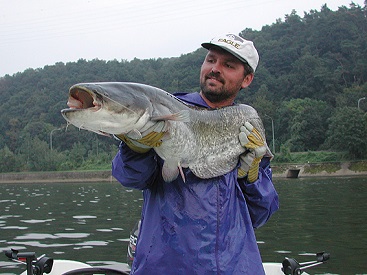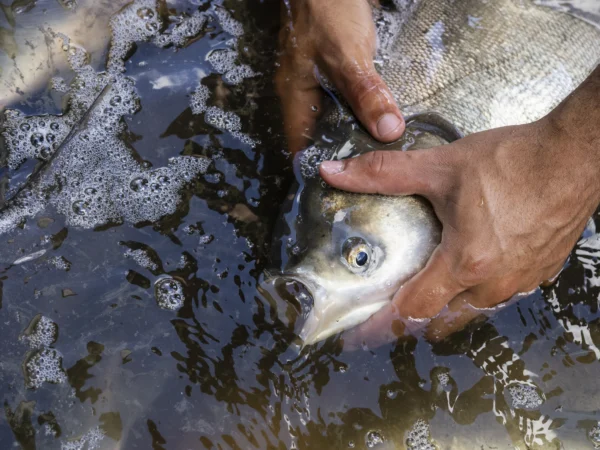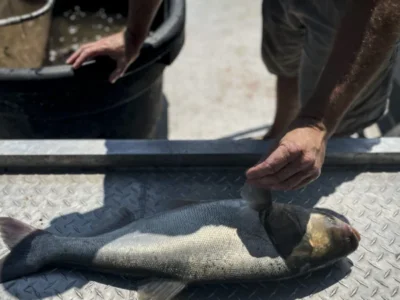
In May, the self-cloning marbled crayfish clawed Michigan and regional headlines by officially becoming an outlaw. And even though the little bugger—a popular species for aquarium aficionados—hasn’t committed any offenses in Michigan yet, wildlife authorities are hoping to stay one step ahead of the critters.
And the same goes for many others.
While aquatic invasive species have already cost Great Lakes governments and industries tens of billions of dollars in recent decades, the push to identify, stop, mitigate and/or eliminate them is a constant battle that often involves obscure species we don’t really hear much about.
One major exception to that generality are the infamous villains, often photographed and videotaped leaping into the air from the Mississippi River systems’ waters: Asian carp.
“The Asian carp is a household name. I don’t know how much awareness the average laymen has about invasive species,” said Mike Piskur, program manager with Great Lakes St. Lawrence Governors and Premiers. “I will say that’s a big part of the work some of the states are doing individually, communication and outreach especially about fishing and boating.”
Piskur said educating people is paramount to the mission of preventing invasive species.
“It’s probably fair to say there’s not a high level of public understanding of the lesser-known species, which is part of the work that needs to be done.”
Michigan’s a leader in invasive species
Tinca tinca, stone moroko, parrot feather and yellow floating heart are a few of the unwanteds on the list. While the names sound interesting and exotic, the results of these species establishing themselves in Great Lakes waters could be devastating.
The problem with invasive species is that it’s really difficult to understand exactly what impact they will have on native species until it’s too late.
That’s why the aquatic invasive species “least wanted list” is needed, Piskur said.
“What we’ve tried to do is create a list that’s big enough to be comprehensive but small enough to be manageable. We started with 16 species and then we added five more in 2018,” he said. “Basically the list is saying these are the major threats to the Great Lakes, these are the ones we really want people to focus on and are our priorities.”
GLSLGP is an executive-level organization which functions as an advanced guard on invasive species matters. Membership is comprised of American Great Lakes governors and two Canadian premiers. And, Piskur said, the members actually get together and meet in person. He described Michigan as a leader on the AIS front.
“Starting in about 2013, former Michigan Gov. (Rick) Snyder, who became the chairman, was interested in actually holding regular meetings,” he said. “Since that time, we’ve had five meetings. For Gov. Snyder this particular area was of interest to him personally.”

Yellow floating heart. (Photo courtesy of the Michigan Department of Natural Resources)
Preventing preferable to removing
None of the 21 species currently on the AIS least-wanted list are currently found in Great Lakes waters, which is exactly how officials want to keep it. The introduction of even the smallest population could be irreversible.
For example, the golden mussel, a small bivalve from China and southeast Asia, is one of the listed species. The mussel has the potential to wreak havoc due to its penchant for prolific colonization. Many Great Lakes industries have suffered due to the same type of colonization by zebra and quagga mussels, which made their way to the lakes from the Black Sea during the 1980s. The extensive colonies clog water lines at power plants, water plants and industrial water intakes. They are a nuisance to swimmers and a financial drain on dozens of industries. For zebras and quaggas, eradication isn’t an option: They’re already here.
“One species most people have knowledge of is zebra and quagga mussels,” said Sarah LeSage, who coordinates the AIS program for the Michigan Department of Environment, Great Lakes and Energy. “While the arrival of zebra mussels in the late 80s spurred a lot of regulatory action at the state and federal level, the reality is the lakes are forever changed by zebra and quagga mussels. There’s no way to go back to those pre-conditions. There’s no going back to something like that.”
The red swamp crayfish, the same tasty crustacean which is popular table fare across the U.S., has recently gained a foothold at several locations in Michigan. Prior to 2017, the Gulf Coast natives were not found in the state’s waters. But that’s changed as well.
“We do have two documented species of invasive crayfish and the red swamp crayfish is one,” said Lucas Nathan, AIS coordinator for the Michigan Department of Natural Resources Fisheries Division. “There is some documentation of them being traded in the pet trade, though now they’re a prohibited species.”
Nathan said possessing live red swamp crayfish in Michigan is illegal. The species can grow to five inches or longer and is more aggressive than the state’s native crayfish, able to outcompete for food and territory.
Nathan said teachers sometimes bring live specimens into classrooms for educational purposes, and that crayfish have been known to end up free outside. In this case, since the red swamp crayfish is found at just a handful of sites, it could turn out well if they can all be located and eradicated. Wildlife officials removed more than 4,000 from a small retention pond in Novi several years ago.
“This will be the fourth year of our response effort, a lot of which is education and public awareness. It’s early enough in the invasion process we might be able to get ahead of it and eradicate this,” he said.
But not all invasives are on the small side. Some are really big, like the wels catfish. It is native to central and eastern Europe and is a prized sportfish because of its size. The fish can grow to lengths of 10 feet and live up to 80 years.
“The wels catfish is a very large predator that can grow so much bigger than our native species they can eat them out of house and home,” Nathan said. “It’s hard to know what type of impact they would have on the Great Lakes, but we know they would have an impact on sport and commercial fisheries because of the amount of biomass they consume.”
Pathways are many
“If you think about the history of aquatic species in the Great Lakes region there are a couple key points. Sea lamprey coming through the Welland Canal is sort of a pivot point for understanding AIS impacts on the Great Lakes,” LeSage explained. “The other is zebra mussel arrival in 1988. You can kind of see the invasion curve.”
Pet shops, bait shops and the aquarium trade offer AIS easy movement around the world, especially during the last two decades.
“With globalizations due to the ease of purchasing live organisms through the Internet, that’s become a big focus for our program,” LeSage said. “Part of the problem is that it’s very difficult to communicate because there’s no brick-and-mortar store. We see diffused distribution chains now where it’s hard to communicate about changes in laws.”
Buyers and sellers are everywhere, she explained, so reaching those people is far more difficult than visiting or corresponding with retail locations or suppliers.
Parrot feather and yellow floating heart, both on the least-wanted list, are two plant species popular in aquariums and water gardens. And LeSage said they’re bad news for Great Lakes states.
“For the most part we’ve found yellow floating heart in smaller water bodies like ponds and historic water gardens where it was intentionally introduced. While every situation is different, with exotic species we have more tools in our toolbox to control AIS in smaller bodies, compared to coastal wetlands or flowing water bodies,” she said.
Like other AIS, yellow floating heart and parrot feather have the ability to spread quickly and dominate a body of water, choking out native plants, clogging drainage ditches and impeding fishing, boating and other activities.

Parrot feather takes over a pond. (Photo courtesy of the Michigan Department of Natural Resources)
While the aquarium industry, including Internet sellers, receive attention from LeSage and other Great Lakes officials, the shipping industry has proven a major mover of invasive species during the last 50 years through ballast water discharges on ships.
Ballast water, pumped in and out of ships to maintain proper balance, has proven a time-worn pathway for organisms from abroad to enter the Great Lakes. Historic hitchhikers include the round goby and zebra and quagga mussels, among dozens of other species.
Bi-lateral legislation in recent years has aimed to curb the threat from ships entering the Great Lakes from foreign countries through various means of water treatment. The treatments include flushing foreign freshwater with saltwater before entering the St. Lawrence Seaway, and chemical and other methods. New standards developed by the U.S. Environmental Protection Agency for treating ballast water discharges aren’t expected to be released until later this year.
“Right now we’re communicating with federal agencies and waiting to hear about EPA draft standards,” LeSage said. “We’ll have to wait and see when they release that information.”
She said shipping companies are working to mitigate the problem, and both states and provinces are involved, though a comprehensive regulatory solution does not yet exist for the Great Lakes.
Difficult to estimate the cost
“In our field of study it’s very difficult to estimate the monetary value of preventing something that didn’t happen,” LeSage explained. “So when you think about investments in prevention versus long-term control after a species is already here, it’s not easy.”
Convincing the public to spend money on a problem that may arise in the future is easier said than done, she said, and that’s a stumbling block in the AIS field. But the bottom line is, prevention is cheaper than mitigation.
“The dollar values spent in terms of economic losses and direct control far exceed those of prevention,” LeSage said. “A good example is the zebra and quagga mussels in cooling intakes for power plants. That’s a cost that is passed on to consumers. But their impact on the Great Lakes fishery because they’re fouling a reef or get into an inland lake – we don’t have a way to control them once they’re here. So it’s difficult to do a cost-benefit analysis. But the bottom line is prevention is always more cost effective.”
Prevention preferred to suppression or eradication
Nathan declined to say that once an invasive species is introduced, fixing the situation is always impossible. Instead, he explained, it’s challenging and sometimes impossible to eradicate.
“If you can catch something early you have higher chances of eradication. But sometimes it’s impossible,” he said. “Suppression is always a management strategy.”
Nathan referenced the sea lamprey, which lake managers have battled for decades through pesticides, barriers and traps. It nearly wiped out the Great Lakes fisheries a half century ago.
“It’s very difficult to knock out an entire species, in particular when you’re dealing with a system like the Great Lakes. Once an individual gets introduced, without a silver bullet, a perfect strategy, it’s almost impossible,” he said. “That’s why it goes back to prevention as that strategy, and it’s the cheapest and most effective strategy to mitigate impact.”
That’s why the general public is so important as part of the strategy, LeSage said.
“I always want people to know what we’re looking for. Clean drain, and dry boats and bait buckets, and never release plants or animals. Reporting is an essential part of our program,” she said. “We can’t be everywhere at once and we put a great deal of value on all of our partners throughout the Great Lakes region to keep an eye on our waters. Let us know what you’re seeing.”
Anyone with knowledge of suspect wildlife is urged to report information to the Midwest Invasive Species Network, operated by Michigan State University.
Read more news on invasive species on Great Lakes Now:
Controlling Invasives: States urge residents to help stop spread of invasive species
Invasive grass carp found in Lake Huron tributary river
Michigan awards $3.6 million for invasive species project
Mercury Levels Maintained: Invasive mussels keep mercury levels high in Great Lakes fish
Featured image: A smaller wels catfish. (Photo courtesy of the Michigan Department of Natural Resources)
1 Comment
-
There’s a genetic solution to eradicate ANY specie,the Australian bioengineer is afraid of its effect on such a large scale in the Great Lakes.Given the disastrous history of this eco-system it is understandable.




